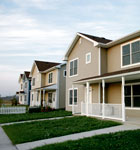At a Glance
Location
Annapolis, MD
Founded
1988
Employees
3
Specialties
Historical preservation, sustainable construction, waterfront planning, and structural logistics
Jeff Halpern, principal architect of Halpern Architects, says he’s never met an architectural style he didn’t like. “We’re very flexible, and that works in our favor,” he says, “because we can design a building that the owner feels is theirs and not something we pulled out of a cookie jar.” Flexibility is one of many skills that give the 24-year-old Annapolis, Maryland-based Halpern Architects a competitive edge. The company is capable of new construction, renovation, space-planning and interior design work, and it specializes in affordably priced modern and traditional homes and maintains a strong reputation to stay on customers’ radars despite the recession.
Halpern’s credentials in his field are impressive. He has chaired the Chesapeake Bay Chapter of the AIA Historic Preservation Committee, and he’s currently an architectural consultant for Annapolis’s Historic Preservation Commission (HPC). He’s also spoken at a number of historical-preservation conferences, and in 2002 he received a Community Preservation Award from the HPC and the Historic Annapolis Foundation.
The architect typically designs homes between 2,000 and 3,800 square feet, but he has also done spaces as large as 14,000 square feet and as small as 1,000 square feet. And, he has aligned his company with a builder and several manufacturers offering green, custom modular housing. One of Halpern Architects’ key competitive strengths is waterfront design. “These properties get hammered with wind-driven rain and lots of sun,” Halpern says. “We took the time to understand how water interacts with the building envelope, how to get water out when it’s driven inward, and how to keep the house from flexing so [that] there are no wind-creaks, drywall cracks, or broken glass.” To reach more of the public, Halpern Architects also designed a home for Extreme Makeover: Home Edition.
The firm has sometimes gone beyond residential work, too. For example, it entered and won a competition to design the Cadillac-LaSalle Club Museum and Research Center in Hickory Corners, Michigan. “We also have taken on projects in West Virginia and Florida and designed the French ambassador’s house in Washington, DC—all projects we might not have taken on in a boom time, but we enjoyed doing them,” Halpern says. Recently, the firm has gone back to its early roots by taking on smaller remodeling projects.
About 10–15 percent of the company’s business today comes from developing conceptual design drawings, which help developers sell unbuilt projects to potential lenders, buyers, and renters. Additionally, Halpern’s master’s degree in architectural structural theory has brought work in structural forensics, where his firm is asked to solve a property’s structural problems, and this has informed his preservation work and modular home building practices. “Understanding structural design in depth allows us to get projects constructed just the way we envision them—architecturally creative, structurally sound, and environmentally friendly—so it’s a win-win,” he says.
The historical-preservation work, in turn, has informed Halpern Architects’ green practices. “Nineteenth-century buildings were completely off the grid, so if you are going to design a modern building that’s energy-efficient, historical preservation can remind us of ideas that have been forgotten from the past,” Halpern says. Working with green modular-home builder Fusion Custom Homes, Halpern and associate architect Alan Cook have designed a series of low-maintenance, smaller homes that produce more electricity than they use so that, over a 10- to 12-year period, they are expected to achieve a negative carbon footprint.
Halpern’s firm has been able to push the structural envelope on projects such as the Cadillac-LaSalle Club Museum thanks to help from tech-savvy partners such as BEI Structural Engineers. “It begins with a dialogue that ends with a creative structural concept to accomplish what we want visually,” he says. “Then BEI computer-models and engineers it to ensure that what we want to do is structurally sound.” Owners and builders love it, he says, because it makes for more interesting projects that are also more efficient to construct.
Despite the difficult times, Halpern Architects’ work still comes primarily from referrals, and the firm can thank its established name for that. “We’re small-town architects, and here people know who we are,” Halpern says. “That’s been a real saving grace.” ABQ


